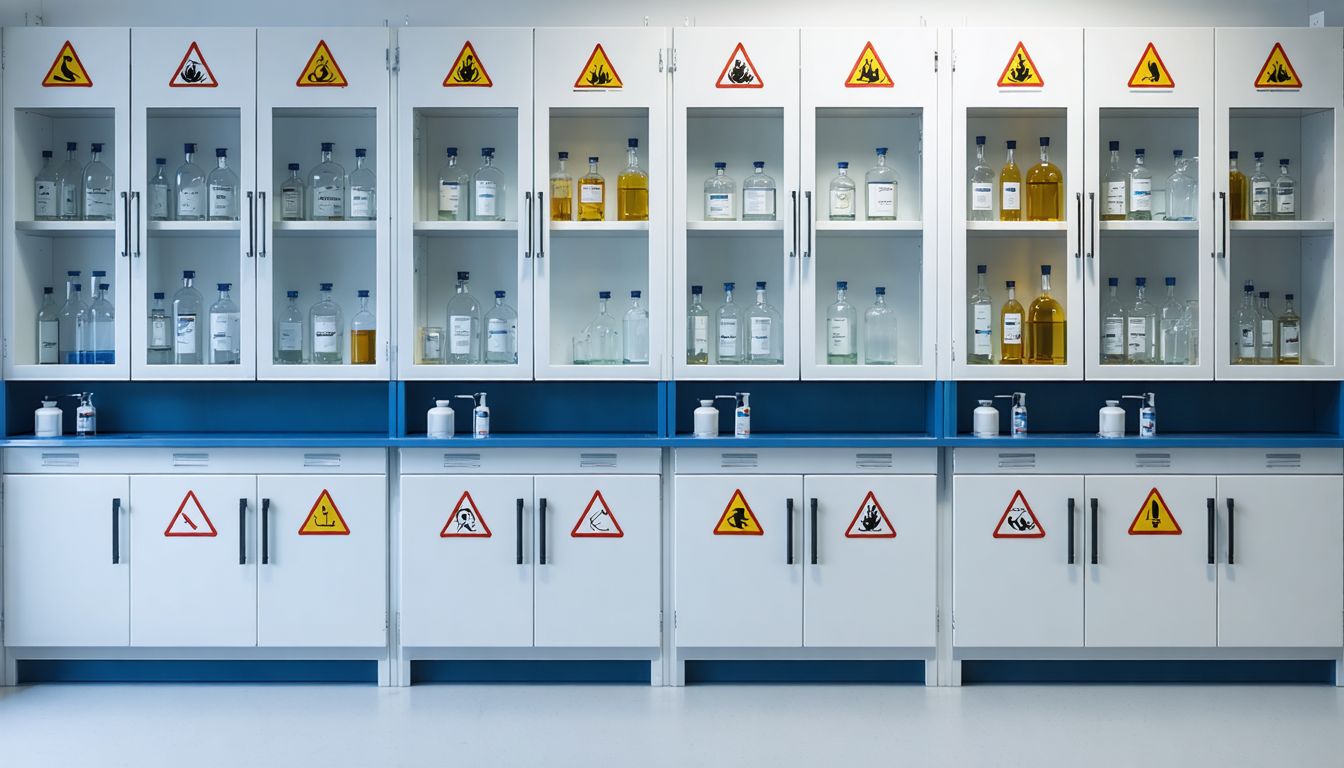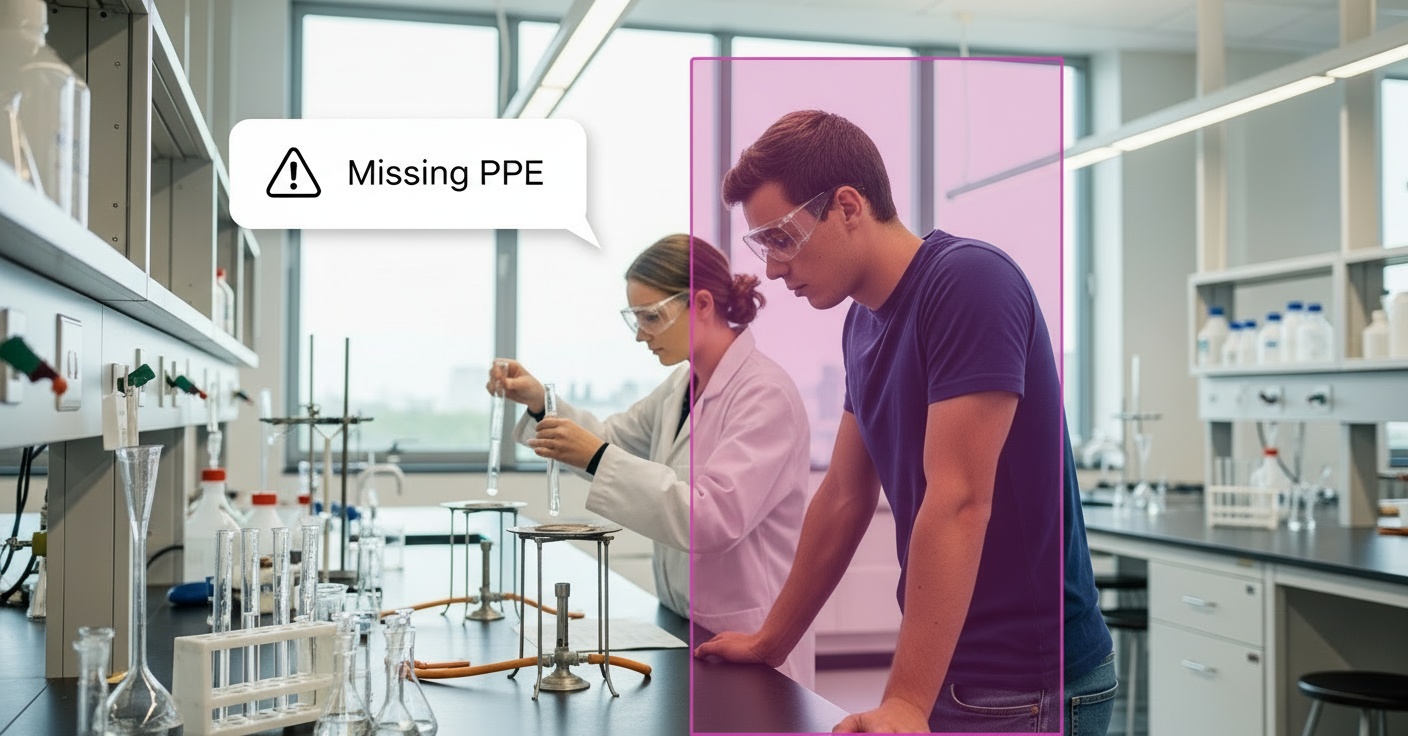Laboratory incidents in schools and universities are a costly and recurring problem. These events disrupt learning, impact budgets, and—most importantly—put students, staff, and faculty at risk. Many educators also report feeling underprepared to manage lab risks, highlighting a critical need for better tools and procedures.
But these incidents can be mitigated. With the right combination of strong protocols and current technology, academic institutions can move from reacting to incidents to anticipating risks to minimize their occurrence. This guide breaks down the true costs, root causes, and offers a clear framework for moving from a reactive to a forward-thinking risk management model using video AI.
Why Laboratory Incidents Are Costly in the Education Sector
Laboratory incidents in academic settings carry a distinct set of risks. Events can result in hospitalization and often involve complex chemical, biological, or physical hazards, making anticipatory measures essential.
The Top 5 Causes of Laboratory Incidents in Education—and How to Stop Them
Understanding where things go wrong is the first step to mitigating them. Here are the five leading causes of lab mishaps in academia, each with actionable mitigation strategies that blend traditional best practices with video AI.
1. Chemical Exposure and Burns

The Hazard:
Chemical handling is the top source of lab injuries. For example, a student might accidentally knock over a bottle of hydrochloric acid during an experiment. Even with gloves, the splash can cause a chemical burn, requiring emergency treatment and hospital admission.
Traditional Mitigation:
Mandatory chemical handling training for all lab users (Source: American Chemical Society).
Strict PPE requirements: lab coats, goggles, gloves (Source: OSHA).
Use of fume hoods and secondary containment.
Emergency showers and eyewash stations within easy reach.
How AI Amplifies Safety:
AI-powered video analytics can detect when individuals enter the lab without proper PPE. Real-time alerts allow supervisors to intervene before a risky experiment begins. By monitoring for unauthorized access to storage areas, AI helps lab managers catch protocol breaches early.
2. Fires and Explosions

The Hazard:
Improper storage or handling of flammable chemicals can quickly escalate. For example, if a technician cleans up spilled hexane, a static spark can ignite the vapors and cause a flash fire.
Traditional Mitigation:
Segregate incompatible chemicals and use flame-proof storage.
Enforce “no ignition sources” policies in volatile areas.
Train on emergency procedures and fire extinguisher use.
Routine compliance audits and regular equipment checks.
How AI Amplifies Safety:
Video AI can identify when unauthorized personnel enter restricted areas. “Person enters no-go zones” analytics flag when someone accesses chemical storage zones or other hazardous areas, supporting faster intervention and safer lab operations.
3. Respiratory Exposure
The Hazard:
Inhalation of toxic fumes or gases is a silent but serious risk. For instance, a researcher mixing chemicals outside a fume hood could unknowingly release vapors, leading to respiratory distress that requires medical attention.
Traditional Mitigation:
Require all hazardous procedures be performed in functioning fume hoods.
Regular maintenance of ventilation systems.
Respiratory protection programs for high-risk tasks.
Air quality sensors and emergency response drills.
How AI Amplifies Safety:
AI video monitoring can verify that personnel are in designated areas when performing high-risk tasks. The system can also detect crowding, unauthorized access, or missing PPE, helping to enforce established procedures and reduce accidental exposures.
4. Sharps-Related Incidents (Needlestick and Cuts)
The Hazard:
Broken glassware or contaminated needles pose a risk of cuts and infections. A student might hurriedly clean up broken glass without proper gloves and sustain a deep cut, or a researcher could have a needlestick incident involving a pathogen sample.
Traditional Mitigation:
Use safety-engineered sharps and puncture-resistant containers.
Train on proper disposal and cleanup procedures.
Enforce glove use during all glass handling or tissue work.
Timely reporting and medical evaluation of any injury.
How AI Amplifies Safety:
Video analytics can detect when required PPE is missing during high-risk tasks. By monitoring activity in sharps disposal areas, AI can help teams spot unsafe behaviors and procedural deviations in real time, reducing the risk of injury and infection.
5. Cryogenic and Cold Burns
The Hazard:
Cryogenic liquids like liquid nitrogen are common in advanced labs. One example: a lab worker attempts to refill a Dewar flask but skips donning thermal gloves. The spill causes a cold burn to the hand, requiring urgent care.
Traditional Mitigation:
Mandatory training for all cryogenic liquid users.
Enforce the use of insulated gloves, face shields, and lab coats.
Clear zone markings and access controls around cryogenic workstations.
Written protocols for safe transfer and emergency response.
How AI Amplifies Safety:
AI video systems can detect missing PPE and flag when people enter restricted cryogenic zones. “Person enters no-go zone” and “missing PPE” analytics support supervisors in maintaining compliance and discouraging hazardous shortcuts.
Integrating a Modern AI Camera System: From NVR to AI Insights for Academia
Improving lab protocols doesn’t mean starting from scratch. An AI camera system integrates directly with your existing cameras—even legacy POE models—so you don’t need a full rip-and-replace project. Here’s how the technical leap works:
Feature |
Traditional NVR System |
Modern AI Camera Platform |
|---|---|---|
Camera Compatibility |
Select new models only |
Works with existing POE/legacy cameras |
Storage |
On-premise hardware |
Secure, cloud-native, scalable |
Maintenance |
Frequent on-site service |
Minimal, remote updates |
User Access |
Limited, siloed |
Unlimited users, unified dashboard |
Video Review |
Manual, time-consuming |
AI-powered search and detection |
Risk & Compliance Insights |
Passive footage |
Automated alerts for missing PPE, unauthorized access, and crowding |
A cloud-native solution bridges your current infrastructure with powerful analytics. That means less on-premises maintenance, scalable storage, and easy user access for compliance, operations, or IT teams. The AI layer analyzes video feeds, surfacing alerts for missing PPE, running, unauthorized entry, and more—turning video footage into an anticipatory risk management tool.
When evaluating this technology, look for platforms that:
Seamlessly integrate with your current cameras and compliance programs.
Support unlimited user access for cross-departmental collaboration.
Deliver AI-powered alerts tailored to academic-specific risks—without creating extra work for your team.
The best technology empowers your people. It doesn’t replace your culture of diligence; it gives you the data and visibility to make it even stronger.
Transform Your Approach to Laboratory Risk Management—Book a Consultation
With the right training, strong protocols, and video AI, academic institutions can protect students, faculty, and research investments.
Want to see how video AI can support your lab risk management strategy? Book a consultation for your school, district, or university and get personalized advice from education safety experts. Book a consultation.
Frequently asked questions
What are the most common causes of laboratory incidents in academic settings?
The most common events include chemical exposure, fires, respiratory exposure from fumes, and injuries from sharps or cryogenic materials. These mishaps often stem from improper handling, missing PPE, inadequate training, or outdated equipment.
How can schools improve lab protocols without overhauling their infrastructure?
AI camera platforms work with your existing cameras—including legacy POE devices—adding an analytics layer that delivers automated risk alerts. This scalable, cloud-based approach means you don’t need to rip and replace hardware.
Are there compliance requirements specific to academic labs?
Yes. Academic labs must comply with federal and state regulations, including OSHA standards like the Bloodborne Pathogens Standard (Source: OSHA). These regulations mandate proper PPE use, chemical storage procedures, and incident documentation. Many institutions also adopt additional standards like NFPA 45 and ISO 45001 for thorough safety management.
How can this technology reduce the workload for compliance teams?
Video AI cuts investigation time by quickly surfacing relevant incidents and trends. Automated alerts for missing PPE, unauthorized access, or unsafe behaviors mean managers can focus on training and forward-thinking measures—not just paperwork.
How to start implementing video AI in our labs?
Begin with a risk assessment: review your existing camera coverage and identify high-risk areas. Involve stakeholders from compliance, IT, and lab operations to align on priorities. Pilot video AI in one area, measure results, then expand based on the data.
What to look for in a video analytics system for lab risk management?
The most effective system aligns with your lab's specific risks. Prioritize a platform that works with your existing cameras to avoid costly hardware replacements. It should offer AI detections tailored to lab hazards, such as missing PPE, unauthorized entry into 'no-go zones' like chemical storage, and crowding. A cloud-native solution with a simple, unified dashboard is also critical, as it reduces IT maintenance and empowers lab managers, compliance officers, and other staff to collaborate on risk management without needing specialized training.
About the author
Joshua Foster is an IT Systems Engineer at Spot AI, where he focuses on designing and securing scalable enterprise networks, managing cloud-integrated infrastructure, and automating system workflows to enhance operational efficiency. He is passionate about cross-functional collaboration and takes pride in delivering robust technical solutions that empower both the Spot AI team and its customers.

























.png)
.png)
.png)